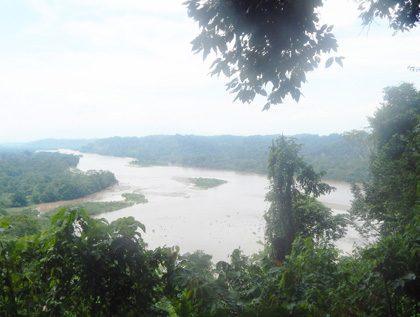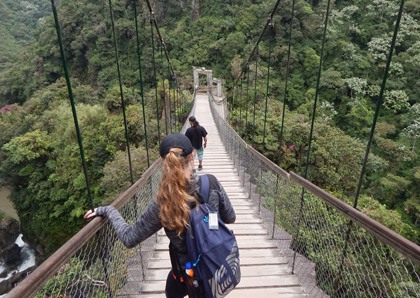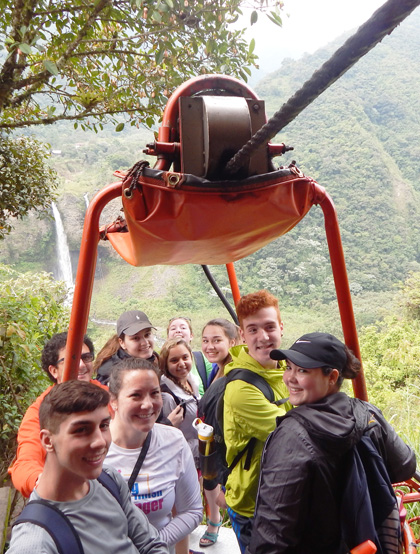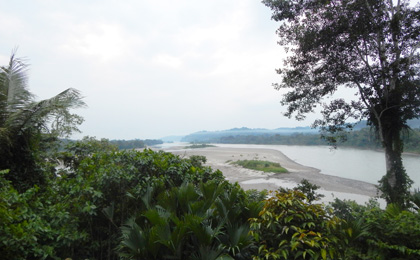If I could sum up Ecuador in a single word, it’d be vibrant. Much of Ecuador’s beauty is illustrated by its long, mountainous ranges and gushing waterfalls to the cities that possessed the country’s rich culture and history. There was never a moment where I felt bored — I was amazed by the people there, the food, and in particular how they led much more slow-paced and relaxed lives compared to ours.
Ultimately, my time in Ecuador was an enriching experience. Aside from being given the chance to become familiar with its regions and sparking a change with the people there, I had come to recognize of how vast our world really is — and so far, I had only seen just a small, wonderful part of it.

Day 1:
It was midnight by the time the plane touched the ground.Our travel had been long and tedious, as we endured hours of shaky turbulence. Sitting in uncomfortable cramp seats and experiencing motion sickness drained me both physically and mentally. Although, once I boarded off the plane and walked into the Quito airport, my exhaustion dissolved into soft buzzing excitement and relief towards the reality that after for what felt like an eternity, we arrived at our destination: Ecuador.
After retrieving our luggage from the baggage claim and checking through airport security, our group met up with the tour director: Lenin Ampudia, who was responsible for making sure our trip would run smoothly: such as making sure everything was properly booked, re-confirming with hotels and operators, organizing our meals, etc. Short introductions were exchanged; and we were informed of the plans for the following week before we boarded a bus to drive into Quito — the capital city of Ecuador — where resided our first hotel: Hotel San Francisco de Quito.
Accustomed to the sounds of wailing sirens in the distance; loud neighbors; and the other obnoxious noises that came late at night back in the U.S.A, I was awestruck at how seemingly peaceful Quito was — as if the silence had wrapped itself like a thick blanket around the city and lulled all its inhabitants to sleep. Combined with the colonial-like buildings that lined the rolling cobblestone streets that went on for miles; the crisp, cool air; and the far-off city lights, resembling the stars looming above, that winked in and out against the darkness, Quito overall possessed a charmingly quaint, Barcelona-esque look.
The city was inviting; and I was tempted to let my wanderlust take over. To me, it felt like Quito urged newcomers like us to explore and unfold the history and secrets that lied within each of its old nook and cranny, every crack and crevice. But unfortunately with our tight schedule, the opportunity to freely wander had to wait for another time. Despite having just landed, we had to travel again the next day.

Day 2:
Checking out of our hotel rooms, we loaded onto the bus and started on the move again around 8 AM. Alongside with Lenin, we met with another tour director: Robin Gallagher (and one more person along the way), who was joining us exclusively for the Amazon visit of the trip.
It was a 7-8 hour ride; we were heading to the river banks of Los Rios through the curving and winding roads that cut through the Andes Mountains region, the longest continental range in the world. I was mesmerized. The mountains were lush and magnificent, lavished by the sun’s brilliance as we drove by, rising and falling across the neverending green landscape that led into the clear-blue expanse — the passing scene was an ideal image for a postcard.
After picking up our last tour director, Macerio, we arrived at Los Rios in the late afternoon. The air was surprisingly hot and humid. We set on a motor canoe to cross the river, watching the surrounding scenery blur by as we glided past. The hum of the engine slowed as the outline of a staircase — leading upwards to what I expected was the Minga Lodge — peeped out from the thick foliage, and came to a complete halt near the bottom steps.
We climbed the stairs and pulled our luggage along a smooth, open-air pathway until we found ourselves at the reception desk. The Minga Lodge was nestled in the jungle wilderness, and the short walk rendered us a stunning view of our rich environment: there were an innumerable amount of plants and flowers that bursted with color; different insect species humming in an endless drone; animals unique to the forest; the unbelievably tall trees. Green, exotic life practically breathed and vibrated around us.
The lodge served as the base for the important component of our tour: the service project, which entailed working with local community members of the Amazon and experiencing their day-to-day jungle life.

Day 3:
Our stay at the Minga Lodge was short. We spent three days there, and the majority of it was spent working. As a group, we visited local farms nearby the lodge and learned how differently the people there lived through stopping at a indigenous community and completing tasks that they had to do every day: like fetching water from the river and learning how to build fences around plant gardens. The central focus of our work, however, was digging trenches in the jungle.
Due to the fact that human population was slowly growing in the Amazon, local resources — revolving around education, healthcare and agriculture — had to be increased in order to cater to all the people there. By digging the trenches, we helped speed up the process of developing a water system; which, would not only allow for the people to have running water in their homes, but also let them save time from walking long distances to retrieve it.
It wasn’t simple. Our tools were limited (we just had hoes, pickaxes, and shovels) and split into small groups.We sweated, despite that we were under the cool shade of the trees, and worked until our muscles became sore and our backs ached. Knowing that we were in a location that straddled the equator, it was vital for us to keep ourselves constantly hydrated.
Throughout the hours we spent digging, I think that by the end of the day, we collectively came to acknowledge the local community’s struggles and how much work they had to do in to sustain themselves. Compared to them, we were privileged to have easy access to things; they weren’t able to get water through the turn of a knob, or electricity through the flick of a switch like we could. And in a way, I felt guilty because of that. But accompanied with my guilt was appreciation, for realizing how fortunate I was; and a sense of motivation that prompted me to want to help the community as much as I could.
It was this portion of our trip that we learned what the term Minga meant. Minga, is about coming together and working towards a common goal that ultimately betters a community, regardless of your differences and interruptions in your own life. It might have not been prominent, but we left the Minga Lodge carrying the knowledge that we helped with opening better future opportunities for the indigenous people.

Final Days:
After we left the Minga Lodge, we returned back into the city, where the remainder of our trip was filled with more sightseeing and tourist attractions.
We spent an entire day in the small city of Baños, located north on the Tungurahua volcano, at the Hostería La Estancia de Dulcelina. Dulcelina held the entire vista of Baños, which was a popular tourist area with streets filled with countless of restaurants and shops. We took our time to do shop at the Town Square for souvenirs; then a visit to a waterfall before we headed back to the city of Quito, where we took a trip to a self-sustaining community deep within the Cloud forest and another shopping day at a traditional, local marketplace.
Our last day wrapped up by a fancy dinner, immediately followed by a drive to the Quito airport on the same night.




